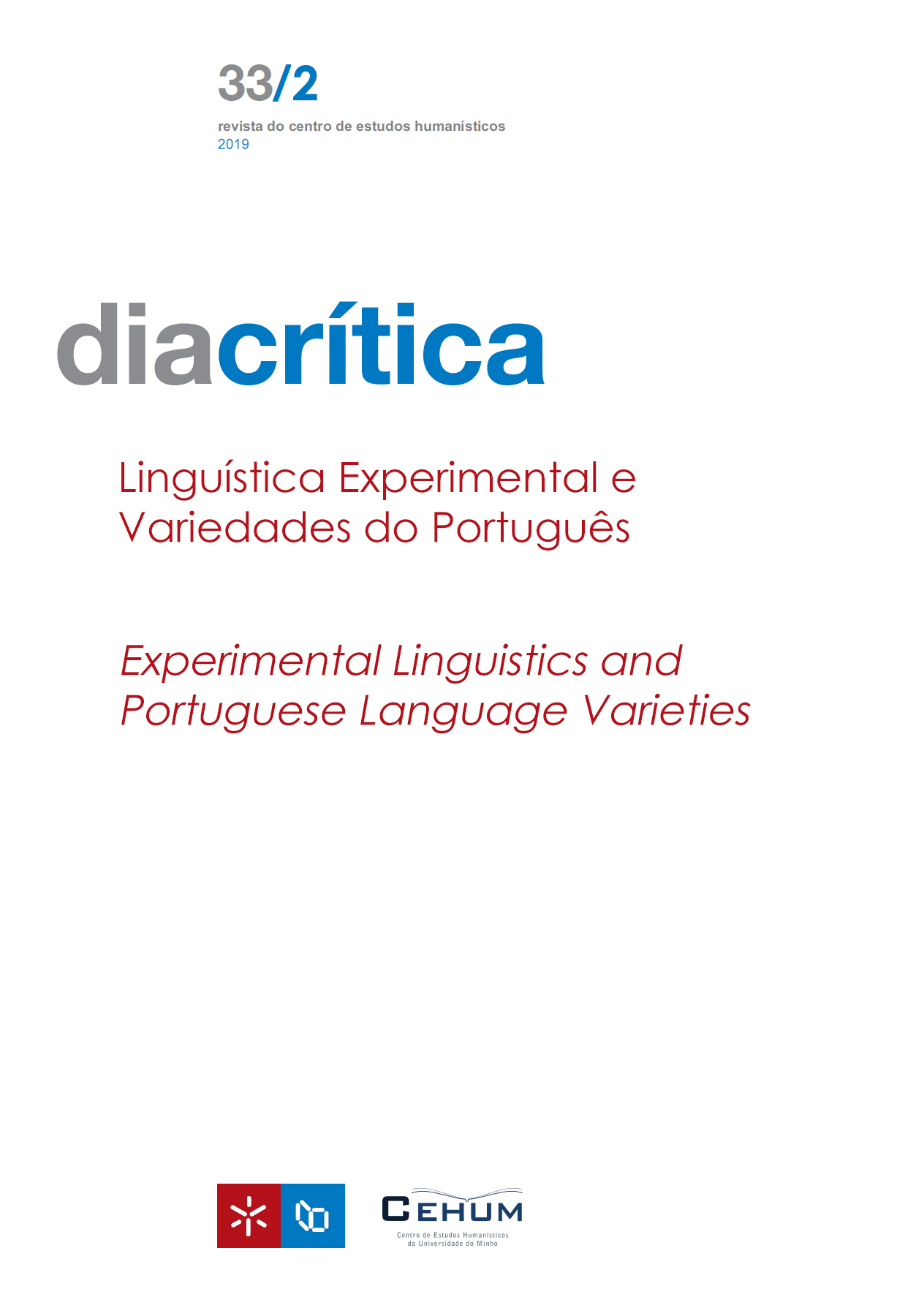The process of inflectional verbal morphology in brazilian portuguese: an eye-tracking study
DOI:
https://doi.org/10.21814/diacritica.5055Keywords:
Language processing, Verbal morphology, Brazilian Portuguese, Eye-trackingAbstract
The processing of inflectional verbal morphology has been the subject of an extensive debate in Psycholinguistics. Dual-mechanism theories (Pinker 1998; Ullmanet al.1997) support processing models in which regular verbal forms are processed via rule computation, while irregular verbal forms are retrieved in the memory. On the other hand, single-mechanism theories (Rumelhart & Mcclelland 1986; Stockall & Marantz 2006) claim either regular and irregular inflected forms can be processed by means of a connectionist mechanism or by a process of morphological decomposition. Much of the evidence accumulated so far has been provided by studies of the English past tense (Pinker 1998; Rumelhart & Mcclelland 1986; Stockall & Marantz 2006; Ullmanet al. 1997). Unlike English, the Portuguese language has a complex verbal morphology. In view of the complexity of Portuguese verbal morphological system, a psycholinguistic experiment using the self-paced reading method associated with eye movement recording was conducted aiming at investigating if regular verbs that belong to different verbal classes and tenses are processed in the same or different way. A total of one hundred and eight native speakers of Brazilian Portuguese participated in the experiment. The results suggest that, in the processing of inflected verbal forms, verbal properties like verbal class and tense as well as syntactic elements that are part of the sentence in which the verb is inserted play a role in the processing of verbs.
References
Albright, A. (2002). Islands of reliability for regular morphology: Evidence from Italian. Language,78, 684–709. https://doi.org/10.1353/lan.2003.0002 DOI: https://doi.org/10.1353/lan.2003.0002
Bandeira, L.A. (2015).The role of typology and proficiency in L2 processing of Brazilian Portuguese and English verbal morphology:An eye-movement study(Dissertação de mestrado, Universidade Federal de Santa Catarina, Florianópolis, Brasil).
Baron, J. (1973). Phonemic stage not necessary for reading. Quarterly Journal ofExperimental Psychology,25(2), 241–246. https://doi.org/10.1080/14640747308400343 DOI: https://doi.org/10.1080/14640747308400343
Bower, G. (1970). Imagery as a relational organizer in associative learning. Journal of Verbal Learning and Verbal Behavior,9(5), 529–533. https://doi.org/10.1016/S0022-5371(70)80096-2 DOI: https://doi.org/10.1016/S0022-5371(70)80096-2
Brovetto, C. (2002).The representation and processing of verbal morphology in the first and second language (Tese de doutoramento, Georgetown University, USA). Disponível emhttps://www.researchgate.net/publication/34272150_The_representation_and_processing_of_verbal_morphology_in_first_and_second_language
Clahsen, H., Heyer, V.&Reifegerste, J. (2016). Editorial.The Mental Lexicon,11(2), 161–163. https://doi.org/10.1075/ml.11.2.001edi DOI: https://doi.org/10.1075/ml.11.2.001edi
De Jesus, D. B. (2018). Efeitos de priming sintático no processamento de sentenças em português brasileiro: um estudo eletrofisiológico(Tese de doutoramento, Universidade Federal de Santa Catarina, Florianópolis, Brasil).
Felício, A. R. (2018).Cross-linguistic syntactic priming effects in sentence comprehension: A study with Brazilian Portuguese-bilinguals(Dissertação de mestrado, Universidade Federal de Santa Catarina, Florianópolis, Brasil). Disponível emhttps://repositorio.ufsc.br/handle/123456789/189175
Kielar, A., Milman, L., Bonakdarpour, B.& Thompson, C.K. (2011). Neural correlates of covert and overt production of tense and agreement morphology: Evidence from fMRI.Neurolinguistics, 24(2),183–201.https://doi.org/10.1016/j.jneuroling.2010.02.008 DOI: https://doi.org/10.1016/j.jneuroling.2010.02.008
Kolers, P. A. (1968). The recognition of geometrically transformed text. Perception &Psychophysics, 3,57–64. https://doi.org/10.3758/BF03212713 DOI: https://doi.org/10.3758/BF03212713
Kostić,A.& Havelka, J. (2002). Processing of verb tense.Psihologija, 35,299–316. https://doi.org/10.2298/PSI0203299K DOI: https://doi.org/10.2298/PSI0203299K
Linares, R. (2011). Conjugations and complex stems in Spanish verbs: generalization properties and priming effects. In M. Maiden, J. C. Smith, M. Goldbach & M.-O. Hinzelin (Eds.),Morphological autonomy: Perspectives from Romance inflectional morphology (pp. 158–181). Oxford, Reino Unido: Oxford University Press. DOI: https://doi.org/10.1093/acprof:oso/9780199589982.003.0009
Murrel, G.&Morton, J. (1974). Word recognition and morphemic structure. Journal of Experimental Psychology,102(6),963–968. https://doi.org/10.1037/h0036551 DOI: https://doi.org/10.1037/h0036551
Mota, M. B. (2012) As assinaturas neurais da aquisição e processamento da morfologia flexional em L2. In H. Moura, M.B. Mota & A. P. Santana (Eds.),Cognição, Léxico e Gramática(pp. 219–233). Florianópolis: Insular.
Orsolini, M.&Marslen-Wilson, W. (1997). Universals in morphological representation: Evidence from Italian. Language and Cognitive Processes,12, 1–47. https://doi.org/10.1080/016909697386899 DOI: https://doi.org/10.1080/016909697386899
Pinker, S. (1998). Words and rules. Lingua,106,219–242. DOI: https://doi.org/10.1016/S0024-3841(98)00035-7
Rayner, K.&Pollatsek, A. (2006).Eye-movement control in reading. In M. Traxler &M Gernsbacher(Eds.), Handbook of psycholinguistics (pp. 613–657). Amsterdão, Países Baixos: Elsevier. DOI: https://doi.org/10.1016/B978-012369374-7/50017-1
Rayner, K. (1998). Eye movements in reading and information processing: 20 years of research. Psychological Bulletin, 124(3),372–422.https://doi.org/10.1037/0033-2909.124.3.372 DOI: https://doi.org/10.1037/0033-2909.124.3.372
Rubenstein, H.,Lewis, S.&Rubenstein, M. (1971). Evidence for phonemic recoding in visual word recognition. Journal of Verbal Learning and Verbal Behavior, 10(6),645–657. https://doi.org/10.1016/S0022-5371(71)80071-3 DOI: https://doi.org/10.1016/S0022-5371(71)80071-3
Rumelhart, D.& McClelland, J. (1986). On learning the past tense of English verbs. In D. Rumelhart, J. McClelland & PDF Research Group(Eds.),Parallel distributed processing: Explorations in the microstructure of cognition (Vol. 2, pp. 216–271).Cambridge, MA: The MIT Press. DOI: https://doi.org/10.7551/mitpress/5236.001.0001
Santos, M. P. (2017).Os efeitos de priming sintático intra e translinguístico no processamento de francês como L2 (Dissertação de mestrado, Universidade Federal de Santa Catarina, Florianópolis, Brasil). DOI: https://doi.org/10.5935/1981-4755.20180017
Stockall, L.&Marantz, A. (2006). A single route, full decomposition model of morphological complexity: MEG evidence. The Mental Lexicon, 1,85–123.https://doi.org/10.1075/ml.1.1.07sto DOI: https://doi.org/10.1075/ml.1.1.07sto
Taft, M. (1979). Recognition of affixed words and the word frequency effect. Memory &Cognition,7(4), 263–272. https://doi.org/10.3758/BF03197599 DOI: https://doi.org/10.3758/BF03197599
Taft, M. (1984). Evidence for an abstract lexical representation of word structure. Memory & Cognition,12(3), 264–269. https://doi.org/10.3758/BF03197674 DOI: https://doi.org/10.3758/BF03197674
Taft, M.&Forster, K. (1975). Lexical storage and retrieval of prefixed words. Journal of Verbal Learning and Verbal Behavior,14(6), 638–647. https://doi.org/10.1016/S0022-5371(75)80051-X DOI: https://doi.org/10.1016/S0022-5371(75)80051-X
Taft, M.& Forster, K. (1976). Lexical storage and retrieval of polymorphemic and polysyllabic words. Journal of Verbal Learning and Verbal Behavior,15(6), 607–620. https://doi.org/10.1016/0022-5371(76)90054-2 DOI: https://doi.org/10.1016/0022-5371(76)90054-2
Ullman, M. T.,Corkin, S., Coppola, M., Hickok, G., Growdon, J. H., Koroshetz, W. J. & Pinker, S. (1997). A neural dissociation within language: Evidence that the mental dictionary is part of declarative memory, and the grammatical rules are processed by the procedural system. Journal of Cognitive Neuroscience,9(2), 266–276.https://doi.org/10.1162/jocn.1997.9.2.266 DOI: https://doi.org/10.1162/jocn.1997.9.2.266
Veríssimo, J.& Clahsen, H. (2009). Morphological priming by itself: A study of Portuguese conjugations. Cognition,112, 187–194.https://doi.org/10.1016/j.cognition.2009.04.003 DOI: https://doi.org/10.1016/j.cognition.2009.04.003
Veríssimo, J. & Clahsen, H. (2014). Variables and similarity in linguistic generalization: evidence from inflectional classes in Portuguese. JournalofMemoryandLanguage, 76, 61–79. https://doi.org/10.1016/j.jml.2014.06.001 DOI: https://doi.org/10.1016/j.jml.2014.06.001
Downloads
Published
How to Cite
Issue
Section
License
Copyright (c) 2023 Julia Sabrina Justino, Mailce Borges Mota

This work is licensed under a Creative Commons Attribution-NonCommercial 4.0 International License.










